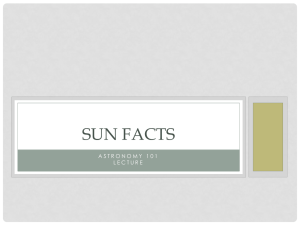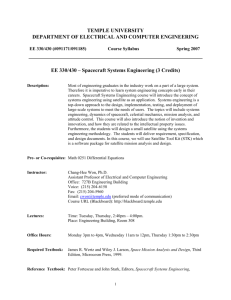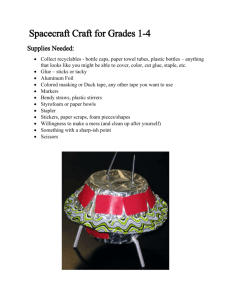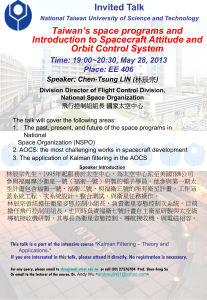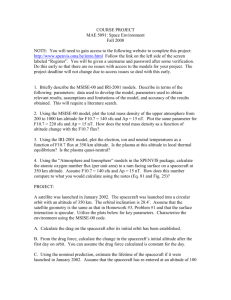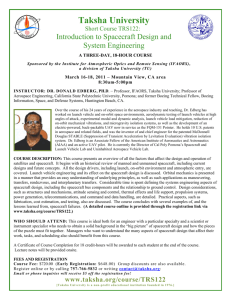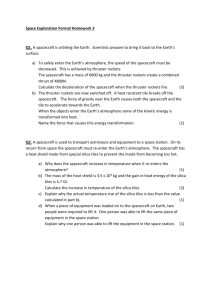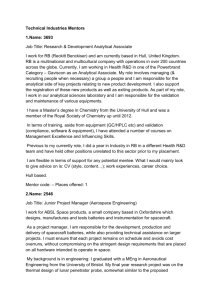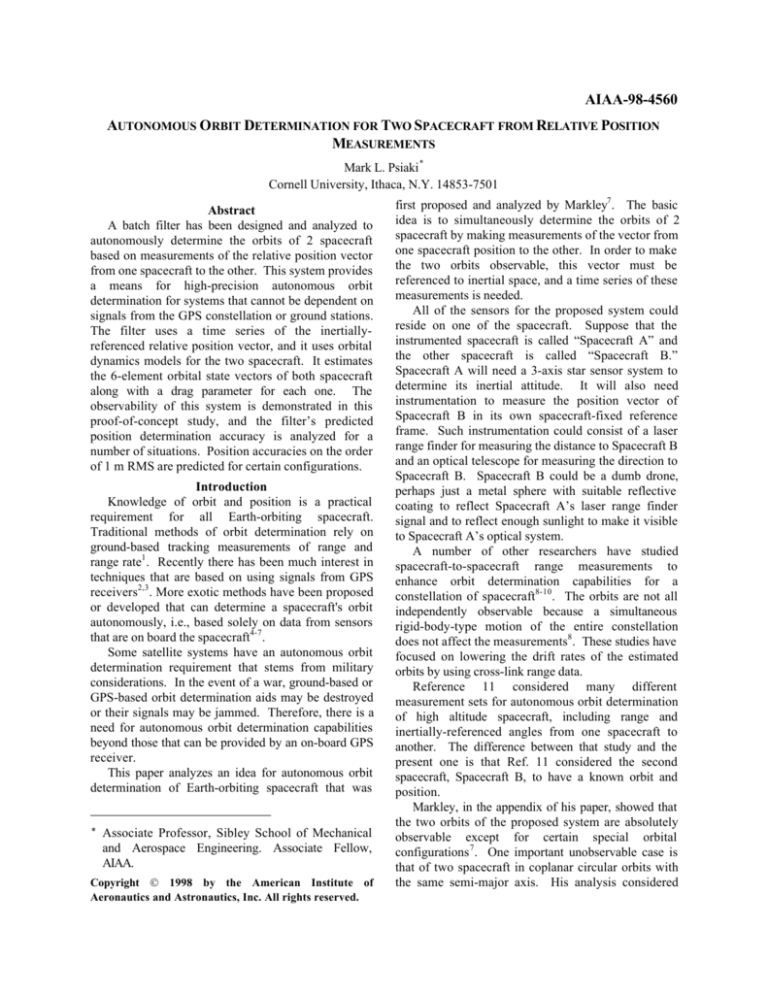
AIAA-98-4560
AUTONOMOUS ORBIT DETERMINATION FOR TWO SPACECRAFT FROM RELATIVE POSITION
MEASUREMENTS
Mark L. Psiaki *
Cornell University, Ithaca, N.Y. 14853-7501
Abstract
A batch filter has been designed and analyzed to
autonomously determine the orbits of 2 spacecraft
based on measurements of the relative position vector
from one spacecraft to the other. This system provides
a means for high-precision autonomous orbit
determination for systems that cannot be dependent on
signals from the GPS constellation or ground stations.
The filter uses a time series of the inertiallyreferenced relative position vector, and it uses orbital
dynamics models for the two spacecraft. It estimates
the 6-element orbital state vectors of both spacecraft
along with a drag parameter for each one. The
observability of this system is demonstrated in this
proof-of-concept study, and the filter’s predicted
position determination accuracy is analyzed for a
number of situations. Position accuracies on the order
of 1 m RMS are predicted for certain configurations.
Introduction
Knowledge of orbit and position is a practical
requirement for all Earth-orbiting spacecraft.
Traditional methods of orbit determination rely on
ground-based tracking measurements of range and
range rate1. Recently there has been much interest in
techniques that are based on using signals from GPS
receivers2,3. More exotic methods have been proposed
or developed that can determine a spacecraft's orbit
autonomously, i.e., based solely on data from sensors
that are on board the spacecraft4-7.
Some satellite systems have an autonomous orbit
determination requirement that stems from military
considerations. In the event of a war, ground-based or
GPS-based orbit determination aids may be destroyed
or their signals may be jammed. Therefore, there is a
need for autonomous orbit determination capabilities
beyond those that can be provided by an on-board GPS
receiver.
This paper analyzes an idea for autonomous orbit
determination of Earth-orbiting spacecraft that was
∗
Associate Professor, Sibley School of Mechanical
and Aerospace Engineering. Associate Fellow,
AIAA.
Copyright 1998 by the American Institute of
Aeronautics and Astronautics, Inc. All rights reserved.
first proposed and analyzed by Markley7. The basic
idea is to simultaneously determine the orbits of 2
spacecraft by making measurements of the vector from
one spacecraft position to the other. In order to make
the two orbits observable, this vector must be
referenced to inertial space, and a time series of these
measurements is needed.
All of the sensors for the proposed system could
reside on one of the spacecraft. Suppose that the
instrumented spacecraft is called “Spacecraft A” and
the other spacecraft is called “Spacecraft B.”
Spacecraft A will need a 3-axis star sensor system to
determine its inertial attitude. It will also need
instrumentation to measure the position vector of
Spacecraft B in its own spacecraft-fixed reference
frame. Such instrumentation could consist of a laser
range finder for measuring the distance to Spacecraft B
and an optical telescope for measuring the direction to
Spacecraft B. Spacecraft B could be a dumb drone,
perhaps just a metal sphere with suitable reflective
coating to reflect Spacecraft A’s laser range finder
signal and to reflect enough sunlight to make it visible
to Spacecraft A’s optical system.
A number of other researchers have studied
spacecraft-to-spacecraft range measurements to
enhance orbit determination capabilities for a
constellation of spacecraft8-10. The orbits are not all
independently observable because a simultaneous
rigid-body-type motion of the entire constellation
does not affect the measurements8. These studies have
focused on lowering the drift rates of the estimated
orbits by using cross-link range data.
Reference 11 considered many different
measurement sets for autonomous orbit determination
of high altitude spacecraft, including range and
inertially-referenced angles from one spacecraft to
another. The difference between that study and the
present one is that Ref. 11 considered the second
spacecraft, Spacecraft B, to have a known orbit and
position.
Markley, in the appendix of his paper, showed that
the two orbits of the proposed system are absolutely
observable except for certain special orbital
configurations 7. One important unobservable case is
that of two spacecraft in coplanar circular orbits with
the same semi-major axis. His analysis considered
only the 1/r2 gravitational force. It demonstrated
mathematical observability without calculating
covariances or predicting accuracy.
The present study makes 4 contributions. First, it
presents explanations for the system's observability.
Second, it shows that the secular J2 effects make some
of Markley's unobservable cases observable. Third, it
calculates covariances based on measurement errors to
predict a lower bound on orbit estimation error, and
fourth, it explores how these covariances vary with
configuration and system parameters such as
spacecraft separation, orbit altitude, and sensor
accuracy.
The remainder of this paper consists of 4 sections
and conclusions. Section 2 uses physics and geometry
to partially explain why the 2 spacecraft orbits are
simultaneously observable. Section 3 describes a
model that has been used to study observability and a
batch filter that has been assumed for purposes of
analyzing its predicted covariance. This section
describes measurement and dynamic models, and it
presents a covariance analysis that will be used to study
observability and accuracy as functions of
configuration and system parameters. Section 4
presents the covariance analysis results. Section 5
presents some additional results and discusses
operational and design issues associated with this
system. Section 6 gives the conclusions.
gravitational acceleration vector with respect to
displacement: G = dg/dr, where g is the gravitational
acceleration vector and r is the position at which the
acceleration is measured. For a simple 1/||r||2
gravitational field, the gravity gradient matrix is
µ
G = − T 5/2 [ ( r T r ) I − 3rr T ]
(1)
(r r)
where µ is the geocentric gravitational constant. Given
this tensor in a spacecraft coordinate system, it is
straightforward to determine the r vector in that
coordinate system, up to a sign.
There exist instruments to measure the gravity
gradient 13.
Conceptually, a gravity gradiometer
consists of an array of very sensitive accelerometers
that are arranged on a spatial grid. The accelerometer
outputs are differenced to determine the spatial
derivatives of the acceleration field.
A gradiometer is difficult to make and use in
practice. For array dimensions that would fit into a
practical spacecraft, a gradiometer requires
accelerometers with an extremely large dynamic range.
Another problem is that spacecraft-generated gravity
gradients can be significant.
The present system can be thought of as a very long
baseline gravity gradiometer. The two spacecraft are
the proof masses of 2 accelerometers in a gravity
gradiometer. Their separation is the baseline of the
gradiometer. The relative position measurements can
be differentiated to determine the relative
acceleration. A non-zero relative acceleration is
caused by the Earth’s gravity gradient. This gravity
gradient depends upon the position of the midpoint
between the 2 spacecraft, which is why the system
yields a signal that can be used for orbit/position
determination. The use of 2 independent spacecraft as
the proof masses allows for large gradiometer
baselines, and all of the problems with gradiometers
essentially go away for large enough baselines. This
system does not measure all of the elements of the G
matrix, but it measures enough of the gravity gradient
to effectively get a very good Earth reference.
Geometric Observability of the Planar Keplerian
Elements
One can understand the observability of the
proposed system by considering orbital geometry.
First, consider the planar case for orbits in a simple
1/r2 gravitational field.
Suppose that the two
spacecraft orbits are in the same plane and that each is
defined by 4 Kepler elements: M0, the mean anomaly
at epoch, M1, the mean motion, e, the eccentricity, and
ω, the argument of perigee. The mean motion is
related to the mean semi-major-axis, a, by the
relationship M12a3 = µ. The semi-major axis and the
II. Physical/Geometrical Explanation of System
Observability
Getting an Earth Reference: A Gravity
Gradiometer Analogy
All of the various systems for autonomous Earth
orbit determination rely on measuring inertial attitude
and the vector or direction to some nearby object, such
as the Earth or the Moon5. The Earth is the most
commonly used nearby object. Its nearness increases
the position accuracy that is achievable for a given
sensor accuracy. Three basic methods exist for using
the Earth as a reference: horizon sensing at CO2
emission wavelengths, refraction of light from nearly
occulted stars, and tracking of landmarks. Each of
these methods has its limitations. The Earth limb, as
defined by CO2 emissions, has about a 5 km
uncertainty.
Stellar refraction has uncertainty
associated with atmospheric effects and limitations
due to the small sample of bright stars in a location
where their light gets refracted. Effective landmark
trackers have yet to be developed, and they also would
be subject to some refraction uncertainty.
Another way to get an Earth reference is through
use of the Earth’s gravity gradient 12. The 3×3 gravity
gradient tensor matrix, G, is the derivative of the
2
nominal situation will be considered. The nominal
situation is that of 2 spacecraft in the same orbit but
with different values of M0 so that there is a difference
in where they are along the orbit. The nominal orbit is
nearly circular, with an apogee altitude of 585 km and a
perigee altitude of 515 km. The spacecraft are
nominally separated by about 100 km, with Spacecraft
B leading Spacecraft A around the orbit.
A
perturbation of the orbital elements will produce
perturbations in ρBA(t) and in ψBA(t). Call these
perturbation time histories ∆ρBA(t) and ∆ψBA(t).
In the discussion that follows a subscript A on a
Kepler element indicates that it belongs to Orbit A, and
a subscript B indicates Orbit B. Thus, M0A is the mean
anomaly at epoch of Orbit A and M1B is the mean
motion of Orbit B.
Consider why the M0 of the 2 spacecraft are
simultaneously observable. If M0A and M0B are
perturbed so that ∆M0A = - ∆M0B, i.e., so that both
spacecraft are perturbed along their respective orbits
in opposite directions, then ∆ρBA(t) is a nonzero
~constant perturbation while ∆ψBA(t) ≅ 0. If, on the
other hand, ∆M0A = + ∆M0B, which perturbs both
spacecraft in the same direction along their respective
orbits, then ∆ρBA(t) ≅ 0 and ∆ψBA(t) is a nonzero
~constant perturbation. These two situations can be
distinguished from each other based on the unique
ways in which they perturb the ρBA(t) and ψBA(t)
responses, Fig. 3.
eccentricity are related to the semi-minor axis, b, by
the relationship b2 = a2(1-e2). Figure 1 depicts the
orbit of a single spacecraft, the geometric definitions
of a, b, and ω, and the true anomaly at epoch, ν0, which
is a function of the mean anomaly at epoch and the
eccentricity: ν0 = ν(M0,e) = M0 + O(e) 14.
Orbit B
r BA(3)
Earth
Line of Nodes
r BA(4)
rBA(2)
r BA(1)
ψBA(2)
Orbit A
Fig. 1 Kepler elements of a planar orbit.
The measurement that will be used to determine the
spacecraft orbits is the inertially-referenced relative
position vector between Spacecraft A and Spacecraft
B, rBA. Figure 2 depicts a sequence of “snapshots” of
this vector as the two spacecraft travel around their
respective orbits. It is clear from these snapshots that
this vector can vary with time in two distinct ways: its
inertial direction, ψBA, can change with time, and its
length, ρBA = ||rBA||, can change with time.
∆ρBA (m)
1000
∆M0A = - ∆M0B = -0.004
o
Orbit B
0
∆M0A = + ∆M0B = +0.01
o
rB A(3)
-1000
Earth
∆ψBA (deg)
Line of Nodes
0.01
rB A(4)
0
rB A(2)
r BA(1)
-0.01
0
ψBA(2)
1000
2000 3000 4000 5000 6000
Time (sec)
Orbit A
Fig. 3 The effects of ∆M0A and ∆M0B on the
perturbation time histories ∆ρBA(t) and
∆ψBA(t).
Perturbations in M1A and M1B produce ramps in
∆ρBA(t) and ∆ψBA(t). If ∆M1A = - ∆M1B, then the two
spacecraft orbit the Earth with different periods. The
difference of orbital periods causes the length of rBA
Fig. 2 Four snapshots of 2 spacecraft and their
relative positive vector, the planar case.
The remainder of this section will show how the
time histories of rBA’s direction and length are locally
unique functions of the 4 Kepler elements of the 2
spacecraft. In order to do this, small perturbations to a
3
to change with time so that ∆ρBA(t) is a ramp. This
change also causes a roughly constant ∆ψBA(t)
perturbation due to the difference in altitudes that
results from the difference in semi-major axes. If
∆M1A = + ∆M1B,, then the two spacecraft orbit together
but at a different common orbital rate. This gives rise
to a ramping ∆ψBA(t) and leaves ∆ρBA(t) ≅ 0. Figure 4
shows ∆ρBA(t) and ∆ψBA(t) for these two perturbation
cases. Obviously, these two cases can be distinguished
from each other and from the cases associated with
Fig. 3.
of a 90o phase difference, as in the case of linearly
independent ∆eA and ∆eB perturbations. They are
distinguishable from ∆eA and ∆eB perturbations
because they give rise to different phase and amplitude
relationships between the ∆ρBA(t) signal and the
∆ψBA(t) signal than are caused by ∆eA and ∆eB
perturbations.
In summary, the 8 planar Kepler elements are
independently observable because 8 linearly
independent perturbations in these quantities give rise
to 8 independent ∆ρBA(t) and ∆ψBA(t) time histories.
∆ρBA (m)
∆ρBA (m)
1000
50
0
0
∆M1A = + ∆M1B = +2.8×10-5rad/herg
-1000
∆ψBA (deg)
-50
∆M1A = - ∆M1B = -1.0×10-5rad/herg
∆ψBA (deg)
0.06
∆eA = - ∆eB = +1.3×10-6
0.01
0.04
0
0.02
0
0
∆eA = + ∆eB = +1.7×10-4
1000 2000
3000 4000
-0.01
0
5000 6000
Time (sec)
1000
2000 3000 4000
5000
6000
Time (sec)
Fig. 4 The perturbation time histories of ∆ρBA(t) and
∆ψBA(t) that are caused by combinations of
∆M1A and ∆M1B.
The simultaneous observability of the two
spacecraft’s eccentricities is more difficult to
understand. Perturbation of each eccentricity causes
once-per-orbit oscillations of ∆ρBA(t) and ∆ψBA(t).
Figure 5 shows the 1-orbit ∆ρBA(t) and ∆ψBA(t)
responses for 2 linearly independent eccentricity
perturbations, one in which ∆eA = -∆eB and the other in
which ∆eA = +∆eB. These plots show distinct phase
differences for the two cases, which make them
distinguishable from each other based upon response
measurements. These cases are distinguishable from
the cases associated with Figs. 3 and 4 because none of
those cases give rise to oscillatory response
perturbations.
Consider perturbations ∆ωA and ∆ωB that
simultaneously enforce ∆M0A = -∆ωA and ∆M0B. = ∆ωB. Any two linearly independent perturbations of
this type cause once-per-orbit oscillations that are
distinguishable from each other and from the
oscillations that are caused by perturbations of ∆eA and
∆eB. They are distinguishable from each other because
Fig. 5 The ∆ρBA(t) and ∆ψBA(t) perturbation time
histories that result from 2 linearly
independent combinations ∆eA and ∆eB.
Geometric Observability of the Orbital Planes
The observability of the 2 orbital planes is partly
explainable from geometry. First, suppose that both
spacecraft are in the same orbital plane. Then rBA stays
in that plane, rotating and changing length. The
rotations are all about the orbit normal vector. The
cross product of rBA with its time derivative indicates
the orbit normal, which defines the orbital plane.
The case of non-coplanar orbits is more
complicated. Suppose that the two orbital planes are
near each other. One might hope that the time average
of rBA×{drBA/dt} would define the normal to an average
orbital plane. If the rBA vector had a component that
was perpendicular to this average orbital plane, then
this out-of-plane component would oscillate. Its
oscillation amplitude would determine the separation
between the two spacecraft orbital planes, and its
oscillation phase would determine where the two
planes intersected.
This information would be
sufficient to uniquely determine both orbital planes.
4
where t is the time since epoch, θ is the colatitude, φ is
the longitude, and r is the geocentric radius. The
equations that define this model come from the
appendix of Ref. 14 and are omitted for brevity's sake.
The following physics are included in the model14:
The 1/r2 gravitational force is the main force. The
motions are modeled as Keplerian motions with small
perturbations due to drag and higher-order gravity
effects. Secular drag effects on mean motion and on
semi-major axis are included, but the secular drag
effect on the decay of the eccentricity is not included.
The secular J2 effects on the argument of perigee and
on the longitude of the ascending node are included as
are the J2 effects on the relationship between the mean
motion and the semi-major axis.
This paper will present filter accuracy results that
are orders of magnitude more accurate than this orbital
dynamics model. In practice, this model is only
accurate to about 6 km when propagated over a single
low Earth orbit with perfectly known initial position
and velocity. Although it seems inconsistent to quote
more accuracy than the dynamic model can achieve,
the use of an inaccurate model for a covariance study
is justified by the following philosophy: The basic
model features that make the system observable are
contained in this crude orbital model. Therefore, a
more accurate dynamic model would not make the
system more or less observable in the mathematical
sense. So, it is not worth the effort to incorporate a
high fidelity model at this stage of the investigation.
As long as a high-fidelity model exists that could
propagate the orbit to the accuracy that the filter
purports to achieve, then the filter’s purported
accuracy could be achieved with real flight data simply
by replacing its dynamic model with the high-fidelity
model.
Model of Measurements. The measurement
model defines the sensor measurements, their error
statistics, and their dependence on p.
The basic measurement is the rBA vector referenced
to inertial coordinates. The error statistics depend on
how the vector is measured. Most likely its length
would be measured by a radio-wave-based or laserbased ranging system. Its direction would be measured
by some other system, possibly an optical telescope.
Directional accuracy would be affected by inaccuracy
of the inertial attitude determination system.
The measurement vector rBA has been decomposed
into length and directional measurements. Suppose
that rBAmeas(k) is the measured value of rBA at sample
time tk and that q$2(k) and q$3(k) are any two unit vectors
Unfortunately, the actual situation is more
complicated. If there is just a 1/r2 gravitational force,
then the above explanation has a weakness: To first
order in the orbital separation, the vector rBA can
remain in a single plane even though the two orbits are
in slightly different planes. This occurs when the 2
spacecraft have the same apogee and perigee and reach
them at the same time 7. As will be demonstrated
below, the secular effects of the J2 gravity term induce
observability in this case, but it is not straightforward
to explain geometrically why the system becomes
observable with J2 effects.
III. System Model, Batch Filter Design, and
Covariance Analysis Technique
System Model
A system model can be used to develop a filter for
estimating the orbits from data, to mathematically
demonstrate observability, and to predict the
covariance of the filter’s estimated orbits.
Estimation Vector. The estimation vector for this
study has 14 elements, 6 Kepler elements plus a drag
parameter for each spacecraft. It is:
p = [M0A, M1A, M2A, eA, ω0A, λ0A, iA, M0B, M1B, M2B,
eB, ω0B, λ0B, iB]T
(2)
where M2 is the drag parameter, ω0 is the argument of
perigee at epoch, λ0 is the longitude of the ascending
node at epoch, and i is the inclination. The “A” and “B”
subscripts refer to Spacecraft A and B, respectively.
The epoch time is defined as t = 0.
The p vector contains no bias or misalignment
estimates. In practice, all of the sensors that would be
used in the proposed system might have biases,
misalignments, or both.
If not corrected, such
measurement errors would degrade system
performance. Some of the biases/misalignments might
be observable given the present set of measurements,
but it is certain that not all of them are observable. The
analysis that follows assumes that the spacecraft would
undergo a calibration period, during which additional
sensor data would be available, such as ground tracking
data. This additional data would be used to determine
any important biases or misalignments that otherwise
would be unobservable.
Model of Orbital Motion. The observability of
the proposed system depends on there being an
accurate model of the orbital motion of each
spacecraft. This study uses a dynamic model that is
based upon physics.
It gives each spacecraft’s
geocentric position as a function of time and orbital
state:
θ = θ(t; M0, M1, M2, e, ω0, λ0, i)
(3a)
φ = φ(t; M0, M1, M2, e, ω0, λ0, i)
(3b)
r = r(t; M0, M1, M2, e, ω0, λ0, i)
(3c)
that are perpendicular to each other and to rBAmeas(k).
5
Suppose, also, that ρBAmeas(k) =
Then the measurement model is
ρBAmeas(k) = ρBA(k) + nρ(k)
T
rBA(k) + n2(k)
0 = q$2(k)
0 =
T
rBA(k)
q$3(k)
+ n3(k)
T
rBAmeas(k)
rBAmeas(k) .
(4a)
(4b)
η1(k)(p) = {ρBAmeas(k) - ρBAmod(k)(p)}/σmag
T
rBAmod(k)(p)}/σdir(k)
η2(k)(p) = {- q$2(k)
(8b)
T
rBAmod(k)(p)}/σdir(k)
η3(k)(p) = {- q$3(k)
(8c)
(8a)
The normalized measurement errors that are defined by
these equations, ηi(k) for i = 1,2,3, have zero mean and
unit variance, according to the statistical model.
There are 2 possible forms of the length model
ρBAmod(k)(p) that gets used in eq. (8a):
(4c)
where nρ(k) is the length error, and n2(k) and n3(k) are
directional errors. They are assumed to be Gaussian
random sequences and to have statistics
E{ nρ(k)} = 0,E{ nρ(j)nρ(k)} = σmag 2δ jk
(5a)
2
E{ ni(k)} = 0, E{ ni(j)ni(k)} = σdir(k) δ jk for i = 2,3
(5b)
E{ nρ(j)ni(k)} = 0 for i = 2,3,
(5c)
E{ n2(j)n3(k)} = 0
(5d)
where σdir(k) = max(ρBAmeas(k)•σang,σdirmin ). In these
equations σmag is the standard deviation (in meters) of
the length measurement error, σang is the standard
deviation (in radians) of the direction measurement
error, and σdirmin is a minimum direction error (in
meters). Note how σang gets multiplied by ρBAmeas(k) in
order to transform it into a length, consistent with the
definitions of n2(k) and n3(k). The quantity σdirmin
models the limiting effects of finite spacecraft size on
directional accuracy for very small separations
between the two spacecraft.
The next part of the measurement model computes
a modeled value rBA(k) as a function of the p estimation
vector. Using the following definitions:
θA(k)(p) = θ(t(k); M0A, M1A, M2A, eA, ω0A, λ0A, iA) (6a)
φA(k)(p) = φ(t(k); M0A, M1A, M2A, eA, ω0A, λ0A, iA) (6b)
rA(k)(p) = r(t (k); M0A, M1A, M2A, eA, ω0A, λ0A, iA) (6c)
θB(k)(p) = θ(t(k); M0B, M1B, M2B, eB, ω0B, λ0B, iB) (6d)
φB(k)(p) = φ(t(k); M0B, M1B, M2B, eB, ω0B, λ0B, iB) (6e)
rB(k)(p) = r(t (k); M0B, M1B, M2B, eB, ω0B, λ0B, iB) (6f)
the modeled rBA function is
rBAmod(k)(p)=
{rB(k) sinθB(k) cos( φB(k)+γ (k) )-rA(k) sinθA(k) cos( φA(k)+γ (k) )}
{rB(k) sinθB(k) sin( φB(k)+γ (k) )-rA(k) sinθA(k) sin( φ A(k)+γ (k) )}
{rB(k) cosθB(k) -rA(k) cosθ A(k) }
(7)
where γ(k) is the Greenwich hour angle at time t(k). This
vector is referenced to Earth-centered inertial
coordinates, as required.
The measured and modeled rBA vectors are used to
derive error equations that can be used in filtering and
in covariance/observability analysis.
The error
equations are derived by substituting the modeled value
of rBA into eqs. (4a)-(4c), solving for the measurement
error vectors, and normalizing the error vectors by
their standard deviations:
ρBAmod(k)(p) =
T
rBAmeas(k)
rBAmod(k) (p)
(9)
T
rBAmeas(k)
rBAmeas(k)
or
ρBAmod(k)(p) =
T
rBAmod(k)
(p)rBAmod(k)(p)
(10)
The first form is the projection of rBAmod(k)(p) along
rBAmeas(k)(p). This form provides better convergence in
a nonlinear least squares batch filter. The second form
is the actual length of the rBAmod(k)(p) vector. For small
values of the angular direction error, σang, both forms
produce similar results. Therefore, the first is to be
preferred because of its better convergence. For large
values of σang, however, the second form of the length
measurement is preferred because it yields a smaller
filter covariance and better consistency between the
actual residuals’ statistics and the modeled statistics.
Nonlinear Least Squares Batch Filter
A batch filter based upon nonlinear least squares
provides one technique for deducing a p estimation
vector from a measurement sequence, rBAmeas(1),
rBAmeas(2), rBAmeas(3), ..., rBAmeas(N) . This filter finds the
value of p that minimizes the nonlinear least-squares
cost function:
N 3
(11)
J(p) = 12 ∑ ∑ η i(k) (p) 2
k = 1 i = 1
which is the sum over all the sample instants of the
squares of the measurement residuals that are defined
in eqs. (8a)-(8c).
Standard iterative gradient-based techniques exist
to solve for a locally minimizing value of the p
vector15. The technique that has been used here is the
Gauss-Newton method with a restricted-length search
step.
A batch filter has been used instead of an extended
Kalman filter because it is more consistent with the
covariance/system-observability analysis that will be
described below and because its software had already
been adapted to orbit determination. A weakness of
this filter is that the statistical effects of random
process disturbances have not been included in its
model.
[
6
]
the time since epoch. The along-track, across-track,
and altitude standard deviation functions are clearly
defined in Ref. 14, in eqs. (11) and (12) of that paper.
For a given data batch, these position component
standard deviations vary with time over the batch
interval. This paper uses the maximum of each
standard deviation over the batch interval as a measure
of estimated spacecraft position accuracy.
Statistical Interpretation and Covariance Analysis
The error equations, eqs. (8a)-(8c), can be used to
develop a statistical interpretation of the batch filter’s
estimation error. Taken over all samples from 1 to N,
the error equations take the form:
η1(1)(p)
η (p)
2(1)
η 3(1) (p)
M
0 = η(p) =
(12)
η1(N)(p)
η 2(N) (p)
η
3(N) (p)
IV. Covariance Analysis Results
The system’s predicted covariance has been
calculated for a number of different cases. These
cases explore the effects of spacecraft separation,
spacecraft relative position, orbital parameters, and
sensor accuracy. Before examining these effects, it is
helpful to present the results of a typical case. This
case will be used as a baseline for analyzing the effects
of various parameter changes.
The baseline case is for both spacecraft in low
Earth orbits such that they stay within 150 km of each
other at all times. Both orbits are nearly circular, both
having an apogee altitude of 585 km and a perigee
altitude of 515 km. Spacecraft B leads Spacecraft A by
an along-track separation that varies between 97.8 and
99.8 km. The orbital planes are slightly different so
that the maximum across-track separation is just 92.8
km. The assumed sensor error statistics are 0.1 m
RMS in range (σmag ), 0.2 arc sec RMS in direction
(σang), and 0.1 m minimum RMS perpendicular to rBA
(σdirmin ). The number of samples used in the data batch
is N = 1,501 with an inter-sample spacing of tk+1 -tk =
3.83 sec; the batch interval equals one orbital period.
The orbit determination accuracy for this case is
very good. The maximum along-track, across-track,
and altitude standard deviations for Spacecraft A are
1.27 m, 0.64 m, and 0.82 m, respectively. The results
for Spacecraft B are essentially identical, and the
similarity of results for the two spacecraft carries over
into all of the cases that have been run, with one
exception. Therefore, only Spacecraft A’s standard
deviations will be reported for most cases.
Figure 6 shows Spacecraft A’s position component
standard deviations as functions of time for the batch
interval. These are the standard deviations implied by
the covariance of the estimated p vector, Ppp. The
values 1.27 m, 0.64 m, and 0.82 m are the respective
maxima of the figure’s three curves.
These results prove that this system is practically
observable.
Its observability Gramian, ATA, is
nonsingular, and its condition is such that good
accuracy can be achieved from these measurements.
This case and various other cases are compared in
Table 1. Each line of that table corresponds to a case.
In each of the table’s cases the two spacecraft orbits
The batch least squares cost function in eq. (11) is the
squared error of these equations.
The Jacobian of the error equations is
1 ∂ρ BAmod(1)
−
σ mag
∂p
∂rBAmod(1)
1
T
∂η
−
q$2(1)
= σ
(13)
A =
∂p
dir(1)
∂p
M
∂rBAmod(N)
1
T
q$3(N)
−
∂p
σ dir(N)
This Jacobian must have full column rank in order for
the system to be observable in the local linearized
sense.
The Jacobian is used to determine the covariance
matrix of the batch filter’s estimated p vector:
Ppp = E{(p - p est)(p - p est)T} = (ATA)-1
(14)
The covariance of p is finite if and only if the system is
observable because ATA is the system's observability
Gramian, and it is nonsingular if and only if the system
is observable.
A practical test of observability is to test the size of
the elements of Ppp. Strict mathematical observability
holds so long as these are all finite, but very large
values indicate that the system is near to being
unobservable, so near that the filter’s estimates will be
useless.
Therefore, practical observability is
investigated by considering the size of the covariance
matrix.
There is a problem in determining what constitutes
“bigness” or “smallness” of an element of the Ppp
matrix. These elements are covariances of Kepler
parameters. The relationship between estimation
errors in Kepler parameters and spacecraft position
estimation errors is nonlinear and complicated.
The solution to this problem is to characterize the
“size” of a given Ppp covariance matrix by the resulting
standard deviations of spacecraft position estimates.
These standard deviations are functions of Ppp and of
7
separation vector's orientation. If the two spacecraft
are near each other and in similar orbits, then the best
accuracy is achieved when there is both significant
maximum along-track separation along with significant
maximum across-track separation or when their is
some eccentricity and the perigee of one orbit is in
phase with the apogee of the other orbit.
The worst relative spacecraft locations occur when
the two altitude time histories are identical and in
phase. In one bad case the two orbits are also coplanar.
In the other bad case the two orbits have no along-track
separation. These are the unobservable cases when
there is only a 1/r2 gravitational force7. When secular
J2 effects are included these cases become observable
(if the inclination is not zero), but accuracy is
degraded.
Several cases have been run to test out the
dependence on separation direction.
They have
characteristics that are almost identical to the nominal
case. In one case Spacecraft B leads Spacecraft A by
100 km in exactly the same orbital plane and with its
altitude time history identical to that of Spacecraft A.
This case would be unobservable if it were not for J2
effects7. This is Case 3 of Table 1. Spacecraft A’s
maximum across-track position standard deviation
increases to 234.3 m, up from 0.64 m in Case 1. Thus,
a lack of across-track separation coupled with a lack of
perigee separation leads to a degradation in acrosstrack orbit determination accuracy, but the system is
still observable, presumably due to the presence of J2
effects. (Note: the correctness of the code has been
verified by removal of the J2 terms, which causes the
across-track variance to go to ∞ for this case.)
A similar result holds when there is a lack of alongtrack separation and the altitude time histories are
identical, as demonstrated by Case 4 of Table 1. In this
case Spacecraft A’s maximum along-track position
standard deviation is 287.6 m, as opposed to 1.27 m
for Case 1. This implies that, although secular J2
effects induce observability in an otherwise
unobservable case, a lack of along-track separation
coupled with a lack of altitude separation degrades the
along-track accuracy.
A case has been run to test what happens when one
spacecraft “orbits” the other. This happens when the
two orbits are similar but their arguments of perigee
are 180o out of phase. This case should be observable
even if the orbits are coplanar 7. The case that has been
run has similar orbital characteristics to the nominal
case except that the spacecraft are coplanar. Its results
are reported as Case 5 in Table 1. The fact that
Spacecraft B is orbiting Spacecraft A shows up in the
minimum and maximum along-track separation of B
have the same apogee and perigee altitudes as the
nominal case: 585 km and 515 km, respectively. Also,
all cases use the sensor accuracies σmag = σdirmin = 0.1
m. Case 1 in Table 1 corresponds to the nominal case
that has just been described. The other cases are
discussed below. The last 3 columns in Table 1, the
ones entitled: “Max. Component σ's,” report the
maximum along-track (A-T), across-track (C-T), and
altitude (Alt.) standard deviations for Spacecraft A’s
estimated orbit.
Component
Variances (m)
1.5
Along-track
1
Across-track
0.5
Altitude
0
0
1000
2000
3000
4000
5000
6000
Time (sec)
Fig. 6 Spacecraft A’s three position component
standard deviations as functions of time, a
typical case.
A very important characteristic of the system is the
distance between the spacecraft. A second case has
been run that is identical to the nominal case except
that the spacecraft are closer to each other by a factor
of 10. It is Case 2 of Table 1. Based on the gravity
gradient analogy, one would expect the accuracy to
decrease because the baseline separation between the
proof masses is decreased without increasing the
accuracy with which their relative positions are sensed.
(Note that σdir remains about the same in both cases
despite the decrease in ρAB for Case 2. σdir remains the
same because it is already near σdirmin in the nominal
case.) The prediction of decreased accuracy is borne
out by the analysis. Spacecraft A’s three position
component standard deviation maxima are almost 10
times larger than for the nominal case -- compare
Cases 1 and 2 in Table 1. Thus, there is an inverse
relationship between the spacecraft separation and the
system accuracy for a given sensor accuracy.
Another significant system characteristic is the
relationship to the two orbits of the spacecraft
8
from A. The accuracy of this case is comparable to
that of Case 1, which shows that practical observability
also holds for this case.
The batch duration also affects the accuracy. If the
batch duration is increased to 2 orbits while the
number of samples remains the same, then the
accuracy improves slightly, as shown by Case 6 of
Table 1. The biggest improvements over the nominal,
Case 1, are in the along-track and altitude maximum
standard deviations.
This is probably due to
improvements in the drag parameter’s accuracy.
The angular accuracy of the rBA measurement, σang,
has a significant impact on the predicted estimation
accuracy. A case has been tried in which σang is
increased from its 0.2 arc sec nominal value to a value
of 2.0 arc sec, which is what might be available from a
less expensive but still high-end attitude determination
system and spacecraft observation telescope. All other
orbital and system characteristics have been kept the
same as in the nominal case. These results are
reported as Case 7 in Table 1. They show 4- to 6-fold
position accuracy decreases, which is not bad
considering the 10-fold decrease in the angular sensor
accuracy.
The effects of orbital parameters have been
investigated. In studying these effects, the following
system characteristics have been held constant at
values like those of the nominal case: Spacecraft B
leads Spacecraft A by an along-track separation that is
nearly constant and equals about 100 km. The orbital
planes are slightly different so that the maximum
across-track separation is about 100 km. The sensor
accuracies are σmag = 0.1 m, σang = 0.2 arc sec, and
σdirmin = 0.1 m. The data batch consists of N = 1,501
samples, and inter-sample spacing is varied from case
to case to keep the batch interval equal to one orbital
period.
The effects of altitude, eccentricity, and inclination
of the 2 spacecraft orbits have been investigated.
Inclination of the average orbital plane has little or no
effect on the system accuracy if the nominal
relationship between the two spacecraft orbits is
maintained. Table 2 reports the effects of the altitude
and eccentricity of the 2 spacecraft orbits. Case 1 of
Table 2 is the same nominal case as Case 1 of Table 1.
Cases 1, 8, and 9 of Table 2 show a modest degradation
of position accuracy with increases in orbital altitude
for nearly circular orbits. Case 9 corresponds to
geosynchronous orbits. At this altitude the positional
standard deviations are about 6 times larger than for
LEO orbits. Case 10 of Table 2 gives results for a pair
of orbits with significant eccentricity. Its maximum
position component standard deviations are only
slightly larger than those of a circular LEO orbit -compare Cases 1 and 10 of Table 2.
Orbital inclination has a marked effect on system
accuracy in two special cases. These corresponds to
the two unobservable cases noted by Markley: the
cases of identical altitude time histories for the two
spacecraft and either zero along-track separation or
zero across-track separation7. As noted above, secular
J2 effects induce observability in these otherwise
unobservable cases, that is, if the orbit is inclined. At
any appreciable inclination J2 has a strong beneficial
effect, as witnessed by Cases 3 and 4 of Table 1, which
fall into these categories but have inclinations of 45o
and 90o, respectively. A case like Case 3, but with
0.25o inclination, produces a maximum across-track
position standard deviation of 3.7x106m. At zero
inclination all such cases revert to being unobservable.
Another case that has been tried is that of 2
spacecraft in very different orbits. Spacecraft A is in a
LEO orbit like the nominal case. Spacecraft B is in a
12-hour orbit, with an apogee altitude of 20,299 km
and a perigee altitude of 20,165 km. In addition, the 2
spacecraft are in very different orbital planes. Sensor
accuracies like those of the nominal case are used.
The data batch contains 1,501 samples with a sample
spacing of 15.32 sec. This translates into a data
interval that includes 4 orbits of Spacecraft A, but only
slightly more than 1/2 of an orbit of Spacecraft B.
This case does not consider occulting of Spacecraft B
by the Earth; thus, the results are optimistic.
The results for this case are very good. Spacecraft
A’s maximum position standard deviations are 0.25 m
along-track, 0.24 m across-track, and 0.01 m in
altitude. Spacecraft B’s maximum position standard
deviations are 0.68 m along-track, 0.95 m across-track,
and 0.02 m in altitude. One might expect these results
to be even better based on the large separations
between the spacecraft. Unfortunately, the growth in
σdir due to its ρBA*σang dependence probably militates
against increased accuracy in this case.
Another interesting case that has been investigated
is that of 2 ballistic missiles. It might be possible to
use this technique to do mid-course orbit
determination for a pair of ballistic missiles in their
coast phase. The case that is considered is that of 2
ballistic missiles that must travel from a launch site to
a target that is 75o away on the Earth’s surface (8,300
km away). The missiles travel in the minimum energy
orbit that is required to traverse this distance, an orbit
with an apogee altitude of 1,289 km. Missile B leads
Missile A by 85.8 km to 101.6 km of along-track
separation, and they have a maximum across-track
separation of 101.6 km. The data batch interval begins
9
when Missile A leaves the sensible atmosphere, at 100
km altitude, and the interval ends when Missile B starts
to re-enter the atmosphere, at 100 km of altitude. For
a sample interval of 1.00 sec. this translates into a total
of N = 1665 samples.
The results for this case are reasonably good. The
maximum along-track standard deviation is 27.79 m,
the maximum across-track standard deviation is 15.47
m, and the maximum altitude standard deviation is
12.20 m. The main reason why these results are not as
good as comparable LEO cases is the shortness of the
batch interval. It is just 1,664 sec. long. The other
LEO cases are 5,745 sec. long, the length of a full
orbit.
Memory and execution time requirements are not
large by current standards. Typical run times in
FORTRAN on a 100 MHz Pentium processor are 2.6
sec. per iteration for a case with 1,501 samples. The
run time varies linearly with the number of samples in
the data batch. The executable code uses double
precision arithmetic and occupies 177 Kbytes of
memory, which includes space for data storage.
One practical aspect of the proposed system that
will need attention in the future is the issue of field-ofview requirements for the instrument that detects the
direction of Spacecraft B in Spacecraft A’s coordinate
system. The best spacecraft orbital relationships
involve either significant across-track deviations or
one spacecraft "orbiting" the other. If the direction
telescope had a narrow field of view, then Spacecraft A
would have to be slewed in order to keep Spacecraft B
in the sensor’s field of view. Alternatively, Spacecraft
B’s position might not be sampled as often as is
assumed in the foregoing analyses. Instead, it’s
position would be sampled only as often as it entered
the direction telescope’s field of view. Such an
operational change would surely decrease the system’s
accuracy. A system study will need to be done to
determine the accuracy and cost tradeoffs involved in
solving the field-of-view issue.
This is just a proof-of-concept study of the
proposed system. Much more work remains to be
done to design and evaluate an actual system with
hardware and operational considerations taken into
account. Although the present study is likely to be
optimistic in its results due to factors that have been
neglected, it is quite possible that a real system will
perform with an accuracy which approaches the figures
that have been reported in this paper.
V. Additional Results and Discussion
The purpose of this section is briefly to discuss
results obtained by filtering simulated truth-model data
and to discuss some operational practicalities of the
proposed system. The truth model results serve to
confirm the correctness of the covariance analysis.
The operational issues address some computational
and sensor requirements for the system.
Truth-model data has been generated, and this data
has been filtered using the batch filter of Section III.
The truth model that has been used is simplistic. It
uses the dynamic and measurement models of Section
III. It inputs a truth value of p into these models and
uses a random number generator to generate the
measurement noise sequences nρ(k), n2(k), and n3(k).
A limited number of truth-model data batches have
been run through the filter. Not enough runs have been
done for a meaningful Monte Carlo statistical analysis,
but these limited results serve to confirm the
covariance analyses results. For example, none of the
truth-model maximum position component errors has
exceeded the corresponding maximum position
component standard deviation by more than a factor of
3. This confirms that the 3σ rule can be applied to the
maximum component standard deviations of Section IV
to predict the worst-case performance on actual data.
The filter converged rapidly for fairly good initial
guesses of the orbital parameters. For the LEO cases
that have been considered, the maximum initial
position errors ranged from 70-150 km. For the
higher altitude orbits, the maximum initial position
errors ranged as high as 4,400 km. The filter took
between 3 and 98 Gauss-Newton iterations to converge
for all cases considered. Many cases converged in
under 15 iterations. Convergence can take a long time
for a very poor initial guess. If eq. (10) is used to
define ρBAmod(k)(p), then the filter requires many more
iterations to converge from a poor initial guess.
VI. Conclusions
This paper has proposed and analyzed a novel
system for autonomously determining the orbits of a
pair of Earth-orbiting spacecraft. The system makes
use of measurements of the position vector of one of
the spacecraft relative to the other in an inertiallyoriented reference system. The system filters these
measurements using a physically-based orbital
dynamics model. The system does not need exact a
priori knowledge of either spacecraft’s orbit
This system has been shown to be absolutely
observable in all but a few special cases that occur at
zero inclination. Both orbits can be completely
determined from a time history of the relative position
vector. The estimation accuracy depends strongly on
the relative spacecraft positions. Accuracy decreases
as the spacecraft get too near to each other. Accuracy
also decreases if the two spacecraft have the same
10
altitude time history and there is either too little alongtrack separation between the spacecraft or too little
separation between their orbital planes. There is a
slight degradation of accuracy as altitude increases.
In a representative case, the covariance from
filtering 1 orbit's worth of data has been computed.
This case has assumed that the relative position vector
measurement accuracies are 0.1 m in range and 0.2 arc
sec in direction and that the two spacecraft are in
similar LEO orbits with 100-km along-track and
across-track separations. The study has predicted a
position accuracy on the order of 1 m RMS per axis
for this case.
Journal of Guidance, Control, and Dynamics,
Vol. 16, No. 1, Jan.-Feb. 1993, pp. 206-214.
7. Markley, F.L., "Autonomous Navigation Using
Landmark and Intersatellite Data," AIAA/AAS
Astrodynamics Conf., Seattle, Washington, Aug.
20-22, 1984.
8. Ananda, M.P., Bernstein, H., Cunningham, K.E.,
Feess, W.A., and Stroud, E.G., "Global Positioning
System
(GPS)
Autonomous
Navigation,"
Proceedings of the IEEE Position, Location,
and Navigation Symposium, 1990, pp. 497-508.
9. Menn, M., “Autonomous Navigation for GPS via
Crosslink Ranging,” Proceedings of the IEEE
Position, Location, and Navigation Symposium,
Las Vegas, NV, Nov. 4-7, 1986, pp. 143-146.
10.
Herklotz, R.L., “Incorporation of Cross-Link
Range Measurements in the Orbit Determination
Process to Increase Satellite Constellation
Autonomy,” Ph.D. Thesis, M.I.T., Cambridge,
Mass., Dec. 1987.
11.
LeMay, J.L., Brogan, W.L., and Seal, C.E.,
“High Altitude Navigation Study (HANS),” Report
No. TR-0073(3491)-1, The Aerospace Corp., June
1973.
(Also, Defense Technical Information
Center Report No. AD-773 835)
12.
Roberson,
R.E.,
“Gravity
Gradient
Determination of the Vertical,” American Rocket
Society Journal , Vol. 31, No. 11, Nov. 1961, pp.
1509-1515.
13.
Metzger, E.H., Jircitano, A., and Affleck, C.,
“Final Report: Satellite Borne Gravity Gradiometer
Study,” Report No. 6413-950001, Bell Aerospace
Textron, Buffalo, New York, March 1976.
14.
Psiaki M.L., "Autonomous Orbit and Magnetic
Field Determination Using Magnetometer and Star
Sensor Data", Journal of Guidance, Control, and
Dynamics, Vol. 18, No. 3, May-June 1995, pp.
584-592.
15.
Gill, P.E., Murray, W., and Wright, M.H.,
Practical Optimization, Academic Press, (New
York, 1981).
References
1. Tapley, B.D., et al., "Precision Orbit Determination
for TOPEX/POSEIDON," Journal of Geophysical
Research, Vol. 99, No. C12, pp. 24,383-24,404,
Dec. 1994.
2. Wu, S.C., Yunck, T.P., and Thornton, C.L.,
"Reduced-Dynamic Technique for Precise Orbit
Determination of Low Earth Satellites," Journal of
Guidance, Control, and Dynamics, Vol. 14, No.
1, Jan.-Feb. 1991, pp. 24-30.
3. Hoech, R., Bartholomew, R., Moen, V., and Grigg,
K., "Design, Capabilities and Performance of a
Miniaturized Airborne GPS Receiver for Space
Applications," Proceedings of the IEEE Position,
Location, and Navigation Symposium, Las
Vegas, NV, April. 11-15, 1994, pp. 1-7.
4. Chory, M.A., Hoffman, D.P., Major, C.S., and
Spector, V.A., "Autonomous Navigation -- Where
We Are in 1984," AIAA Paper No. 84-1826,
Proceedings of the AIAA Guidance and Control
Conf., Seattle, Washington, Aug. 1984, pp. 27-37.
5. Chory, M.A., Hoffman, D.P., and LeMay, J.L.,
"Satellite Autonomous Navigation -- Status and
History," Proceedings of the IEEE Position,
Location, and Navigation Symposium, Las
Vegas, NV, Nov. 4-7, 1986, pp. 110-121.
6. Psiaki M.L., Huang L., and Fox S.M., "Ground Tests
of Magnetometer-Based Autonomous Navigation
(MAGNAV) for Low-Earth-Orbiting Spacecraft",
11
Table 1
Spacecraft A Position Standard Deviations as Functions of System Parameters for LEO Orbits
==============================================================================
Case
rBA(along-track)
|rBA(across-track)|
σang
N
(tk+1 -tk)
Max. Component σ's
min.
max.
max.
A-T
C-T
Alt.
(km)
(km)
(km)
(arc sec)
(sec)
(m)
(m)
(m)
1
97.8
99.8
92.8
0.2
1,501
3.83
1.27
0.64
0.82
2
9.8
10.0
9.3
0.2
1,501
3.83
12.1
5.71
7.62
3
99.6
100.6
0.0
0.2
1,501
3.83
1.20
234.3
1.13
4
-0.4
0.4
100.2
0.2
1,501
3.83
287.6
2.13
4.53
5
-39.9
240.0
0.0
0.2
1,501
3.83
1.14
1.02
1.20
6
102.4
103.8
92.4
0.2
1,501
7.66
0.56
0.44
0.26
7
97.8
99.8
92.8
2.0
1,501
3.83
5.33
2.80
4.60
==============================================================================
Table 2
Spacecraft A Position Standard Deviations as Functions of Orbital Apogee and Perigee
===========================================================
Case
Apogee
Perigee
Max. Component σ's
A-T
C-T
Alt.
(km)
(km)
(m)
(m)
(m)
1
585
515
1.27
0.64
0.82
8
1,000
930
1.36
0.68
0.88
9
35,912
35,659
7.72
3.93
5.02
10
3,200
500
1.67
0.73
1.15
===========================================================
12

